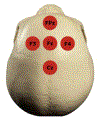EEG-Spectra-Guided Personalized rTMS in PTSD with Co-occurring Psychiatric Disorders: A Case Series
- PMID: 40129500
- PMCID: PMC11931688
EEG-Spectra-Guided Personalized rTMS in PTSD with Co-occurring Psychiatric Disorders: A Case Series
Abstract
Personalized repetitive Transcranial Magnetic Stimulation (PrTMS®) offers an individualized approach to neuromodulation through customized treatment protocols. This case series aims to explore therapeutic outcomes of PrTMS® in two patients with post-traumatic stress disorder (PTSD), based on standardized rating scale scores and spectral EEG-guided alpha brainwave activity optimization. Participants diagnosed with PTSD received PrTMS® treatments informed by quantitative rating scales and weekly spectral EEG measurements. Weekly psychometric assessments showed an improvement in symptoms, as quantified by PCL-5 (Posttraumatic Stress Disorder Checklist for DSM-5), GAD-7 (Generalized Anxiety Disorder 7-item scale), PHQ-9 (Patient Health Questionnaire-9), and SCI (Sleep Condition Indicator) questionnaires. Specifically, PCL-5 scores demonstrated an average reduction of 20.5 points by the midpoint of treatment (4 weeks), while GAD-7 and PHQ-9 scores decreased by 7 and 8.5 points, respectively, at the end of 7 weeks. Mean SCI scores increased by 6 points by the end of the 7 week-treatment period. While previous studies have also highlighted the role of spectral EEG-directed personalized PrTMS in the treatment of PTSD, ongoing research is needed in order to understand the long-term efficacy of PrTMS®.
Keywords: Alpha Brainwave Activity; Neuromodulation; PCL-5 (Post-Traumatic Stress Disorder Symptom Severity Checklist for DSM-5); PTSD (Post-Traumatic Stress Disorder); Personalized Repetitive Transcranial Magnetic Stimulation (PrTMS®); Repetitive Transcranial Magnetic Stimulation (rTMS); Spectral EEG; Spectral Electroencephalogram.
Conflict of interest statement
Conflict of Interest Statement There are no conflicts of interest declared by the authors regarding publication of this paper. This manuscript has been read and approved by all authors.
Figures
Similar articles
-
Personalized repetitive transcranial magnetic stimulation (prtms®) for post-traumatic stress disorder (ptsd) in military combat veterans.Heliyon. 2023 Aug 8;9(8):e18943. doi: 10.1016/j.heliyon.2023.e18943. eCollection 2023 Aug. Heliyon. 2023. PMID: 37609394 Free PMC article.
-
Preliminary Observations of Personalized Repetitive Magnetic Stimulation (PrTMS) Guided by EEG Spectra for Concussion.Brain Sci. 2023 Aug 9;13(8):1179. doi: 10.3390/brainsci13081179. Brain Sci. 2023. PMID: 37626535 Free PMC article.
-
Individually guided neuromodulation in special operator veterans with symptoms of PTSD and traumatic brain injury: preliminary data from a chart review.Front Neurol. 2025 Feb 13;16:1495034. doi: 10.3389/fneur.2025.1495034. eCollection 2025. Front Neurol. 2025. PMID: 40017534 Free PMC article.
-
Clinical Repetitive Transcranial Magnetic Stimulation for Posttraumatic Stress Disorder, Generalized Anxiety Disorder, and Bipolar Disorder.Psychiatr Clin North Am. 2018 Sep;41(3):433-446. doi: 10.1016/j.psc.2018.04.007. Psychiatr Clin North Am. 2018. PMID: 30098656 Review.
-
Explore the durability of repetitive transcranial magnetic stimulation in treating post-traumatic stress disorder: An updated systematic review and meta-analysis.Stress Health. 2024 Feb;40(1):e3292. doi: 10.1002/smi.3292. Epub 2023 Jul 15. Stress Health. 2024. PMID: 37452747
References
-
- Mayo Clinic Staff. “Post-traumatic stress disorder (PTSD)”. Mayo Clinic.
-
- Angelakis S and Nixon RDV. “The Comorbidity of PTSD and MDD: Implications for Clinical Practice and Future Research”. Behaviour Change 32.1 (2015): 1–25.
Grants and funding
LinkOut - more resources
Full Text Sources



